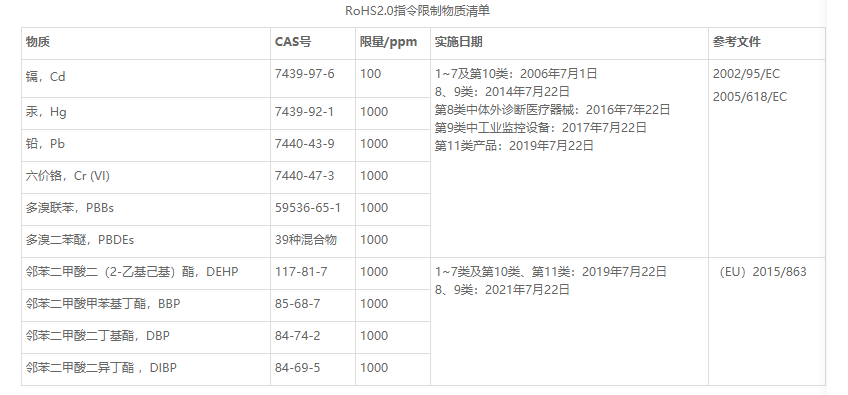Product Inspection
Summary:
RoHS is a mandatory standard established by EU legislation, officially known as the "Directive on the Restriction of the Use of Certain Hazardous Substances in Electrical and Electronic Equipment" (Restriction of Hazardous Substances). This standard has been officially implemented since July 1, 2006, primarily to regulate the material and process standards of electrical and electronic products, making them more beneficial to human health and environmental protection. The purpose of this standard is to eliminate six substances in electrical and electronic products: lead, mercury, cadmium, hexavalent chromium, polybrominated biphenyls, and polybrominated diphenyl ethers (Note: the correct Chinese name for PBDE refers to polybrominated diphenyl ethers, while polybrominated biphenyls is an incorrect term), with a specific regulation that the lead content must not exceed 0.1%. The RoHS directive (2011/65/EU, RoHS 2.0) officially came into effect on July 21, 2011, replacing the previous 2002/95/EC. The EU RoHS 2.0 directive (2011/65/EU) Article 4, Paragraph 1 requires: Member States must ensure that electrical and electronic products placed on the market, including cables and spare parts used for repair, reuse, upgrading their functions, or enhancing their capacity, do not contain substances listed in Annex II. The list of restricted substances under RoHS 2.0 is shown in the table below: Among them, four phthalates were officially added to the RoHS 2.0 directive's restricted list by amendment (EU) 2015/863 on June 4, 2015, as detailed in the official addition of four phthalates to the RoHS 2.0 restricted substances.
RoHS is a mandatory standard established by EU legislation, officially known as the "Directive on the restriction of the use of certain hazardous substances in electrical and electronic equipment" (Restriction of Hazardous Substances). This standard has been officially implemented since July 1, 2006, primarily to regulate the material and process standards of electrical and electronic products, making them more beneficial to human health and environmental protection. The purpose of this standard is to eliminate six substances in electrical and electronic products: lead, mercury, cadmium, hexavalent chromium, polybrominated biphenyls, and polybrominated diphenyl ethers (Note: the correct Chinese name for PBDE refers to polybrominated diphenyl ethers, while polybrominated biphenyls is an incorrect term), with a specific regulation that the lead content must not exceed 0.1%. The RoHS directive (2011/65/EU, RoHS 2.0) officially came into effect on July 21, 2011, replacing the previous 2002/95/EC.
The EU RoHS 2.0 directive (2011/65/EU) Article 4, Paragraph 1 requires: Member States shall ensure that electrical and electronic products placed on the market, including cables and spare parts used for repair, reuse, updating their functions, or enhancing their capacity, do not contain substances listed in Annex II. The list of restricted substances in RoHS 2.0 is shown in the table below:
The EU RoHS 2.0 directive (2011/65/EU) Article 4, Paragraph 1 requires: Member States shall ensure that electrical and electronic products placed on the market, including cables and spare parts used for repair, reuse, updating their functions, or enhancing their capacity, do not contain substances listed in Annex II. The list of restricted substances in RoHS 2.0 is shown in the table below:

Among them, four phthalates were officially included in the RoHS 2.0 directive restriction list by amendment (EU) 2015/863 on June 4, 2015. For details, see the official addition of four phthalates to the RoHS 2.0 restricted substances.
Key words:
Sanitary ware testing
Filter test
REACH test
Eu RoHS testing
Building materials testing
Food contact materials testing
Other testing items
Contact Us
Address:
Room 1116, Yitian Center Building, 121 Tongji Road, Jiangbei District, Ningbo City
Other product testing

